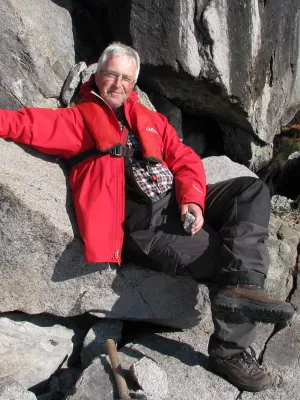
Leif Johansson
Professor emeritus

The role of advective fluid flow and diffusion during localized, solid-state dehydration: Sondrum Stenhuggeriet, Halmstad, SW Sweden
Author
Summary, in English
A localized dehydration zone, Sondrum stone quarry, Halmstad, SW Sweden, consists of a central, 1 m wide granitic pegmatoid dyke, on either side of which extends a 2.5-3 m wide dehydration zone (650-700 degrees C; 800 MPa; orthopyroxene-clinopyroxene-biotite-amphibole-garnet) overprinting a local migmatized granitic gneiss (amphibole-biotite-garnet). Whole-rock chemistry indicates that dehydration of the granitic gneiss was predominantly isochemical. Exceptions include [Y + heavy rare earth elements (HREE)], Ba, Sr, and F, which are markedly depleted throughout the dehydration zone. Systematic trends in the silicate and fluorapatite mineral chemistry across the dehydration zone include depletion in Fe, (Y + HREE), Na, K, F, and Cl, and enrichment in Mg, Mn, Ca, and Ti. Fluid inclusion chemistry is similar in all three zones and indicates the presence of a fluid containing CO2, NaCl, and H2O components. Water activities in the dehydration zone average 0.36, or XH2O = 0.25. All lines of evidence suggest that the formation of the dehydration zone was due to advective transport of a CO2-rich fluid with a minor NaCl brine component originating from a tectonic fracture. Fluid infiltration resulted in the localized partial breakdown of biotite and amphiboles to pyroxenes releasing Ti and Ca, which were partitioned into the remaining biotite and amphibole, as well as uniform depletion in (Y + HREE), Ba, Sr, Cl, and F. At some later stage, H2O-rich fluids (H2O activity > 0.8) gave rise to localized partial melting and the probable injection of a granitic melt into the tectonic fracture, which resulted in the biotite and amphibole recording a diffusion profile for F across the dehydration zone into the granitic gneiss as well as a diffusion profile in Fe, Mn, and Mg for all Fe-Mg silicate minerals within 100 cm of the pegmatoid dyke.
Department/s
- Lithosphere and Biosphere Science
Publishing year
2006
Language
English
Pages
3-33
Publication/Series
Journal of Petrology
Volume
47
Issue
1
Document type
Journal article review
Publisher
Oxford University Press
Topic
- Geology
Keywords
- Sondrum
- localized dehydration
- brines
- CO2
- charnockite
- fluids
Status
Published
ISBN/ISSN/Other
- ISSN: 0022-3530

